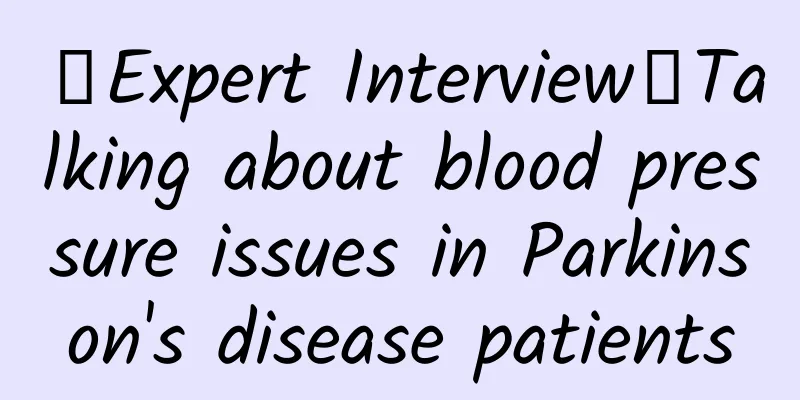【Expert Interview】Talking about blood pressure issues in Parkinson's disease patients

|
Written on the upcoming 28th World Parkinson's Day =========================== Since 1997, the European Parkinson's Disease Association has designated April 11th of each year as World Parkinson's Disease Day. This day is the birthday of Dr. James Parkinson, a British surgeon who discovered Parkinson's disease. Parkinson's disease is a common neurological disorder that mainly affects middle-aged and elderly people, and most of them develop after the age of 60. Its symptoms include involuntary tremors of the hands, head or mouth when at rest, muscle stiffness, slow movements, and postural balance disorders, which lead to the inability to take care of oneself. Today, let's talk about the blood pressure problem of Parkinson's disease. (Zhang Qiaojun) Blood pressure issues in Parkinson's disease patients Parkinson's disease is a chronic neurodegenerative disease. Parkinson's patients not only have to deal with motor symptoms characterized by tremor, muscle rigidity, bradykinesia, and abnormal posture and gait, but also face the challenges of various non-motor symptoms and complications. Some drugs used to treat Parkinson's disease may even aggravate other symptoms. One of the most difficult problems is postural hypotension. Different from general hypotension, postural hypotension is a significant drop in blood pressure when the patient changes from a sitting or lying position to a standing position. In severe cases, it may cause dizziness, vertigo, or even fainting. Drugs for the treatment of Parkinson's disease, such as Madopar and dopamine receptor agonists, may affect the patient's blood pressure, further increasing the complexity of management. The blood pressure problem of Parkinson's patients is a long-standing problem. Common abnormal blood pressure conditions among patients include postural hypotension, supine hypertension, and postprandial hypotension. There may be problems with both high blood pressure and low blood pressure. It's really not good at all. Alas, what should I do? 1. Postural hypotension: Postural hypotension is the blood pressure problem that patients are most concerned about. The pathogenesis of postural hypotension mainly includes three aspects: denervation of sympathetic nerves inside and outside the heart, destruction of the integrity of the pressure receptor reflex arc, and the use of anti-Parkinson's disease drugs. One of the main reasons for Parkinson's disease patients with postural hypotension is that damage to the nervous system affects the control of vascular regulation. Due to Parkinson's disease causing autonomic nervous system dysfunction, patients may not be able to adjust their blood pressure quickly, especially when standing up quickly from lying or sitting. This symptom of postural hypotension not only brings discomfort to patients, but also may increase the risk of falling. To deal with postural hypotension, long-term monitoring of blood pressure in supine and standing positions is essential, and some factors that may cause orthostatic hypotension need to be avoided, such as long-term hot water baths, drinking a lot of alcohol, sitting or squatting for a long time and suddenly standing up. In addition, wearing elastic stockings during exercise can also reduce the occurrence of postural hypotension. Severe postural hypotension can be treated with drugs. The most commonly used drugs are midodrine and droxidopa. Patients must follow the doctor's instructions and pay special attention to the possibility of aggravating nocturnal supine hypertension during treatment. Some drugs can be used, but they must be taken at the right time under the guidance of a doctor. For example, midodrine, 2.5 mg, 1-2 times a day, up to 6 tablets a day, and avoid taking it 4 hours before going to bed. 2. Supine hypertension Studies have found that 15% to 34% of Parkinson's disease patients will experience supine hypertension. Some Parkinson's patients already have hypertension. In addition, it may be related to the use of anti-Parkinson's disease drugs, sympathomimetic drugs, mineralocorticoids and vasoconstrictor drugs. Most patients with supine hypertension do not have any clinical symptoms, but nocturnal hypertension increases the risk of cardiovascular and cerebrovascular failure, renal failure and death. How should we weigh the pros and cons and carry out appropriate treatment? For supine hypertension, treatment should be based on the severity of the patient's hypertension and whether it has caused damage to the target organs. Treatment is necessary when systolic blood pressure is ≥180 mmHg and/or diastolic blood pressure is ≥110 mmHg; some short-acting antihypertensive drugs can be selected under the guidance of a doctor. For Parkinson's disease patients with both postural hypotension and supine hypertension, both non-drug and drug treatments for supine hypertension will aggravate postural hypotension, which may cause related complications such as falls and fractures. Treatment of postural hypotension should be given priority, and mild to moderate supine hypertension is allowed. Specialists need to weigh the pros and cons of antihypertensive and pressor drugs. 3. Why do you feel dizzy and weak after a meal? Some patients, especially those with orthostatic hypotension, may experience symptoms such as dizziness, general fatigue, and even syncope after meals. This is a manifestation of postprandial hypotension. To deal with postprandial hypotension, we can eat small meals frequently, avoid full meals, and avoid eating foods with a high glycemic index. In addition, acarbose delays the absorption of glucose by inhibiting α-glucosidase on the brush edge of the small intestine and reducing the decomposition of complex carbohydrates. People with autonomic dysfunction who suffer from postprandial hypotension can take acarbose before meals to reduce the decrease in systolic and diastolic blood pressure after meals and effectively control symptoms. The adverse reactions of acarbose are mainly gastrointestinal discomfort and gastrointestinal flatulence. In addition, patients with severe liver and kidney damage should use acarbose with caution. 4. Effects of anti-Parkinson's disease drugs on blood pressure Parkinson's disease drugs may have a certain effect on blood pressure (2) Amantadine promotes dopamine release, reduces dopamine reuptake, and has an anti-acetylcholine effect. It is often used to treat early Parkinson's disease and improve tremors, fatigue, etc. However, it may affect blood pressure. If the patient has postural hypotension, it needs to be used under monitoring. The patient should pay close attention to changes in blood pressure and make adjustments based on the doctor's advice. (3) Pramipexole hydrochloride (Senforol), ropinirole, and piribedil (Tayson) are all dopamine receptor agonists that are widely used in the treatment of Parkinson's disease. They can be used alone or in combination with Madopar to reduce the dosage of the drug and the occurrence of movement complications. However, dopamine receptor agonists may impair the systemic regulation of blood pressure, and their use may be accompanied by blood pressure fluctuations. Piribedil (Tayson) treatment also carries the risk of postural hypotension, but the risk is relatively smaller than that of other dopamine receptor agonists. It is very common for patients receiving this type of drug treatment to experience adverse reactions such as lowered blood pressure. Special attention should be paid to increasing the dose under the guidance of a doctor and starting with a small dose. (4) Many adverse reactions of rasagiline, selegiline, and kodan are related to enhanced dopamine activity, so these drugs may aggravate postural hypotension caused by madopar. (5) Trihexyphenidyl is a central anticholinergic drug that helps restore the balance of dopamine and acetylcholine in the brain of Parkinson's patients and improves their symptoms. It is currently believed that treatment with trihexyphenidyl will not have a significant effect on the patient's blood pressure. In short, drugs for the treatment of Parkinson's disease have diverse effects on patients' blood pressure, so when using these drugs, patients need to closely monitor changes in blood pressure. Reasonable drug management and dosage adjustment are the key to ensuring that patients minimize the risk of orthostatic hypotension while controlling Parkinson's disease symptoms. Patients should also communicate with their doctors regularly and report any symptoms of abnormal blood pressure in a timely manner, such as dizziness, vertigo, or other discomfort after standing up, so that appropriate measures can be taken to maintain overall health. After reading the above explanation, do patients have more understanding and more confidence? If you have any problems related to blood pressure, remember to consult a professional doctor. Professor Zhang Qiaojun's team is experienced in the diagnosis and treatment of Parkinson's disease. If you have any questions, please consult the outpatient department. |
<<: 2024 World Oral Health Day Wall Chart | Oral Health Myths List
Recommend
Can I eat hot pot during early pregnancy?
Everyone loves the deliciousness of hot pot. Hot ...
What should I do if I cannot get my car inspected during the epidemic? What should I do if my car inspection is due during the epidemic?
We all know that vehicle inspection is a common p...
Treatment of mycoplasma infection in women
There are many common diseases in life. Different...
What should you pay attention to when protecting your pregnancy?
Pregnant women with threatened miscarriage, a his...
25 days of bleeding
Under normal circumstances, bleeding after aborti...
How to take care of women's private parts
Women's bodies are very delicate. Various gyn...
Are you afraid of "nuclear"? — After radioactive seed implantation, the patient's tumor disappeared
Lung cancer is the most common cancer in the worl...
Is it normal for vaginal discharge to be a little yellow?
Leucorrhea is a special fluid secreted by the fem...
Treatment and nursing of pregnant women infected with Toxoplasma gondii
When a pregnant woman first contracts toxoplasmos...
Who is suitable for cervical cancer vaccine?
Cervical cancer is the most common cancer among w...
Causes of non-menstrual bleeding
The symptoms of non-menstrual sexual bleeding are...
What is the most effective medicine for adenomyosis?
Adenomyosis is a common gynecological disease, wh...
How to reduce milk supply if there is too much milk?
After giving birth, the first thing to worry abou...
Round, white and plump, the protagonist of the Lantern Festival, eat it this way to be healthy!
Lantern Festival Healthy Eating Guide Introductio...
Sprout Social: 2022 US Social Media Trends Report
Sprout Social released the "2022 US Social M...









